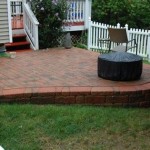Resurfacing a Concrete Patio: A Comprehensive Guide
Concrete patios, while durable and cost-effective, can succumb to wear and tear over time. Cracks, stains, and surface imperfections detract from their aesthetic appeal and can even pose safety hazards. Rather than replacing the entire patio, resurfacing offers a practical and economical solution. This article provides a detailed overview of the concrete patio resurfacing process, covering various methods, materials, and essential considerations.
Understanding the Need for Concrete Patio Resurfacing
Before embarking on a resurfacing project, it's crucial to assess the condition of the existing concrete. Minor surface imperfections, such as hairline cracks and discoloration, are common and easily addressed. However, extensive damage, including large cracks, significant spalling (flaking), or uneven settling, may necessitate more extensive repairs or even replacement. A thorough inspection will determine the appropriate resurfacing approach and the types of materials required.
Several factors contribute to the deterioration of concrete patios. Exposure to harsh weather conditions, including freeze-thaw cycles, can cause cracking and spalling. Chemical exposure from de-icing salts, fertilizers, or spills can also damage the surface. Furthermore, inadequate construction practices, such as improper mixing or curing, can lead to premature failure. Understanding the root cause of the damage is essential for preventing recurrence after resurfacing.
Resurfacing is not just about aesthetics; it also enhances the patio's functionality and safety. A smooth, even surface reduces the risk of trips and falls. Repairing cracks prevents water from penetrating the concrete, which can exacerbate damage during freezing temperatures. Moreover, a resurfaced patio is easier to clean and maintain, extending its lifespan and preserving its value.
Common Concrete Patio Resurfacing Methods
Several methods are available for resurfacing concrete patios, each with its own advantages and disadvantages. The choice of method depends on the extent of the damage, the desired aesthetic outcome, and the homeowner's budget and skill level.
Overlay Systems:
Overlay systems involve applying a thin layer of cementitious material over the existing concrete surface. These overlays can be made from various materials, including polymer-modified concrete, epoxy coatings, and micro-toppings. Polymer-modified concrete is a popular choice due to its durability, flexibility, and resistance to cracking. Epoxy coatings offer excellent chemical resistance and are often used in areas exposed to spills or harsh chemicals. Micro-toppings are very thin overlays that can be used to create a smooth, seamless surface.The application of an overlay system typically involves several steps. First, the existing concrete surface must be thoroughly cleaned and prepared. This may involve pressure washing, grinding, or acid etching to remove dirt, debris, and loose material. Next, a bonding agent is applied to the surface to ensure proper adhesion of the overlay. Finally, the overlay material is applied in one or more layers, depending on the desired thickness and texture. Various finishing techniques, such as stamping, staining, or scoring, can be used to enhance the appearance of the overlay.
Concrete Stamping:
Concrete stamping involves creating patterns and textures on the surface of freshly poured or overlaid concrete. This is achieved using flexible polyurethane stamps that are pressed into the concrete while it is still wet. A wide variety of stamp patterns are available, replicating the look of natural stone, brick, tile, or even wood. Concrete stamping offers a cost-effective way to achieve a high-end look without the expense of installing natural materials.Successful concrete stamping requires careful planning and execution. The concrete must be properly mixed and poured to the correct consistency. The stamps must be applied in a timely manner, before the concrete begins to harden. The stamps must also be properly aligned to create a seamless pattern. After the concrete has hardened, it is often stained or sealed to enhance its appearance and protect it from the elements.
Concrete Staining:
Concrete staining involves applying a chemical stain to the surface of the concrete to create a permanent color change. Concrete stains are available in two main types: acid-based stains and water-based stains. Acid-based stains react chemically with the concrete, creating a mottled, variegated appearance that is unique to each slab. Water-based stains are more consistent in color and offer a wider range of color options. Concrete staining can be used to enhance the natural beauty of concrete or to create a custom design.Before applying a concrete stain, the surface must be thoroughly cleaned and prepared. This may involve pressure washing, grinding, or acid etching to remove any sealers, coatings, or contaminants. The stain is then applied using a brush, roller, or sprayer. Multiple coats may be required to achieve the desired color intensity. After the stain has dried, it is typically sealed to protect it from fading and wear.
Essential Steps in the Concrete Patio Resurfacing Process
No matter which resurfacing method is chosen, certain steps are fundamental to achieving a successful and long-lasting result. These steps encompass preparation, application, and post-application care.
Surface Preparation:
Proper surface preparation is paramount to the success of any concrete resurfacing project. The existing concrete surface must be clean, sound, and free of any contaminants that could interfere with the adhesion of the new material. This typically involves removing loose debris, dirt, oil, grease, and existing coatings. Pressure washing is often used to remove loose material and dirt. More stubborn contaminants may require the use of chemical cleaners or mechanical abrasion, such as grinding or sanding.Cracks and other imperfections must be repaired before resurfacing. Small cracks can be filled with a concrete patching compound. Larger cracks may require the use of a crack injection system or a more extensive repair method. It's crucial to choose a repair material that is compatible with the existing concrete and the resurfacing material. Addressing these imperfections proactively ensures a smooth and durable finished surface.
Material Selection:
Choosing the right materials is crucial for the success of the resurfacing project. Factors to consider include the extent of the damage, the desired aesthetic outcome, the climate, and the budget. For example, polymer-modified concrete overlays are a good choice for patios that are exposed to freeze-thaw cycles, as they are more resistant to cracking than traditional concrete. Epoxy coatings are a good choice for patios that are exposed to spills or harsh chemicals. It's also important to choose materials that are compatible with each other. For example, if using a concrete stain, make sure it is compatible with the sealer that will be applied afterwards.Application Techniques:
Following the manufacturer's instructions is essential for proper application of the resurfacing materials. This includes mixing the materials according to the specified ratios, applying the materials at the correct thickness, and allowing the materials to cure for the recommended time. Proper application techniques will ensure that the resurfaced patio is durable, long-lasting, and aesthetically pleasing. Inconsistent or incorrect application can lead to premature failure, uneven surfaces, and unsatisfactory aesthetics.Post-Application Care and Maintenance:
After the resurfacing material has been applied and cured, it's important to protect it from damage. This may involve applying a sealer to protect the surface from stains and UV damage. It's also important to avoid using harsh chemicals or abrasive cleaners on the resurfaced patio. Regular cleaning with a mild soap and water solution will help to keep the patio looking its best. Addressing spills and stains promptly will prevent them from penetrating the surface and causing permanent damage.In regions with harsh winter climates, consider applying a de-icing agent that is specifically formulated for concrete. Avoid using rock salt or other de-icing agents that can damage the concrete surface. Protecting the resurfaced patio from the elements will help to extend its lifespan and preserve its appearance.
Concrete patio resurfacing offers a viable alternative to complete replacement, providing a fresh, updated look while extending the lifespan of the existing structure. By understanding the various resurfacing methods, materials, and essential steps involved, homeowners can achieve successful and long-lasting results, enhancing the beauty and functionality of their outdoor living spaces.

3 Concrete Resurfacing Options For Patio

4 Ways To Resurface Concrete In Minutes

Resurfacing A Concrete Patio For Budget Diy Makeover Fab Everyday

Why Concrete Patio Resurfacing Is Better Than Replacement Creative Solutions

Concrete Patio Resurfacing Coatings Houston Tx Sundek

Concrete Patio Resurfacing Coating Options Ideas Sundek

Stamped Concrete Resurfacing Riverview Fl

Concrete Resurfacing Tutorial Countertop Experts

Concrete Resurfacing Long Island Infinity Floors Best Contractor In The Tri State

3 Concrete Resurfacing Options For Patio
Related Posts








